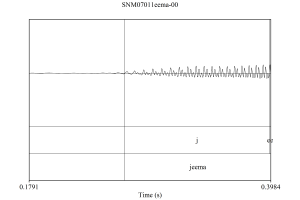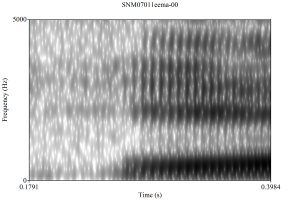In this post, I’d like to informally detail two phonotactic constrains in Okinawan: the bimoraic constraint and the word-initial non-syllabic onset constraint.
| Bilabial | Alveolar | Alveolo-Palatal | Palatal | Velar | Glottal | |
|---|---|---|---|---|---|---|
| Tenuis Stop | (p) b | t d | k g | ʔ | ||
| Palatalized Stop | (bʲ) | ʔʲ | ||||
| Labialized Stop | kʷ gʷ | ʔʷ | ||||
| Flap | ɾ | |||||
| Affricate | (ts dz) | tɕ dʑ | ||||
| Fricative | s (z) | ɕ | h | |||
| Nasal | m | n | ||||
| Approximant | j | w |
Table 1: Okinawan consonants.
Table 1 details Okinawan consonants. Consonants in parentheses are marginal, occurring only on onomatopoeia (as is the case for /p/ and /bʲ/) or in the speech of people historically from the gentry (or the Shuri sociolect) (as is the case for /ts/, /dz/, and /z/, which have merged with /tɕ/, /dʑ/, /dʑ/ in the speech of people historically who were commoners (or the Naha sociolect).
The first constraint I’m going to discuss is the bimoraic constraint.
(1) The Bimoraic Constraint
If a phonological word is one syllable, it must be two mora in length.
So what is a mora in Okinawan? Vowels count as one mora each, syllabic nasals count as one mora, and geminate consonants count as one mora. For one syllable words, this means the following shapes are possible:
(2) Monosyllabic words in Okinawan
CVV – [jaa] ‘house’, [ʔʲaa] ‘you (nonpolite)’, [ʔaa] ‘bubble’
CVN – [ʔin̩] ‘dog’, [sun̩] ‘to do’, [mun̩] ‘thing’
QCV – [kkʷa] ‘child’, [ttɕu] ‘person’ (these may be the only two words of this shape)
The potential shapes *V , *VV, *VVC and *VCC do not occur. *V, and *VVC do not occur due to the fact that they inherently violate the bimoraic constraint. *VCC does not occur as it has no potential historical antecedents. Finally, the CCV shape is limited to QCV (where QC is a geminate version of C). As we have seen, the bimoraic constraint cannot explain all of these non-occurring forms, specifically *VV. For that, we need at least one more constraint that holds for all phonological words in Okinawan: the word-initial onset constraint.
(4) The Word-Initial Onset Constraint
A phonological word must begin with an onset.
Note that there are potential counter-examples of this constraint. For instance, [ʔeema] ‘interval’ contrasts with [eema] ‘Yaeyama’, with the latter apparently not having an onset, though it did historically (< *yaema < PR *ya-pe+yama |eight-layer.CLF+mountain|; I have no explanation for the missing syllable). Speakers, however, typically add a consonant (in this case the glide /j/) to repair the supposed violation of this constraint. Recordings of this word in particular from the Shuri-Naha Hōgen Onsei Dētabēsu pretty clearly reflects this, as does an acoustic look at the word:

Figure 1 – Waveform of [jeema]

It seems in most cases that speakers repair violations of this constraint, but there may be a few onomatopoeia and para-linguistic sound patterns that violate this constraint.
Both of these constraints and how I define a mora in Okinawan have significant influence on how I analyze Okinawan phonology. For instance, counting geminate consonants as a mora means that I must propose palatalized and labialized glottal stops—typologically quite rare—because otherwise a word like *[ʔjaa] (which I analyze as [ʔʲaa] ‘you (nonpolite)’) would violate the bimoraic constraint (as it would have three morae).
We also have two contrasting sets of words which have a syllabic nasal as the nucleus for their first syllable. For instance, we must analyze what is written as <ンニ> or <Nni> (with the capital <N> stands for a syllabic nasal) ‘breast, chest’ as [nn̩ni], rather than *[n̩ni], as the latter violates the word-initial onset constraint. Note that this contrasts with a glottal-stop initial [ʔn̩ni] ‘rice (plant)’. Historically, these seem to make sense to me, as the former originally had a consonantal onset (Proto-Ryūkyūan *mune ‘breast, chest’), while the latter did not (Proto-Ryūkyūan *ine ‘rice (plant)’). This constraint seems to be a Northern Ryūkyūan innovation, as southern Ryūkyūan varieties do not face this restriction; compare Ōgami Miyako [ɑmi] ‘rain’ (a Southern Ryūkyūan variety), Yamato Amami [ʔamï] (a Northern Ryūkyūan variety), and Shuri-Naha Okinawan [ʔami] ‘rain’ (another Northern Ryūkyūan variety), all from Proto-Ryūkyūan *ame ‘rain’.